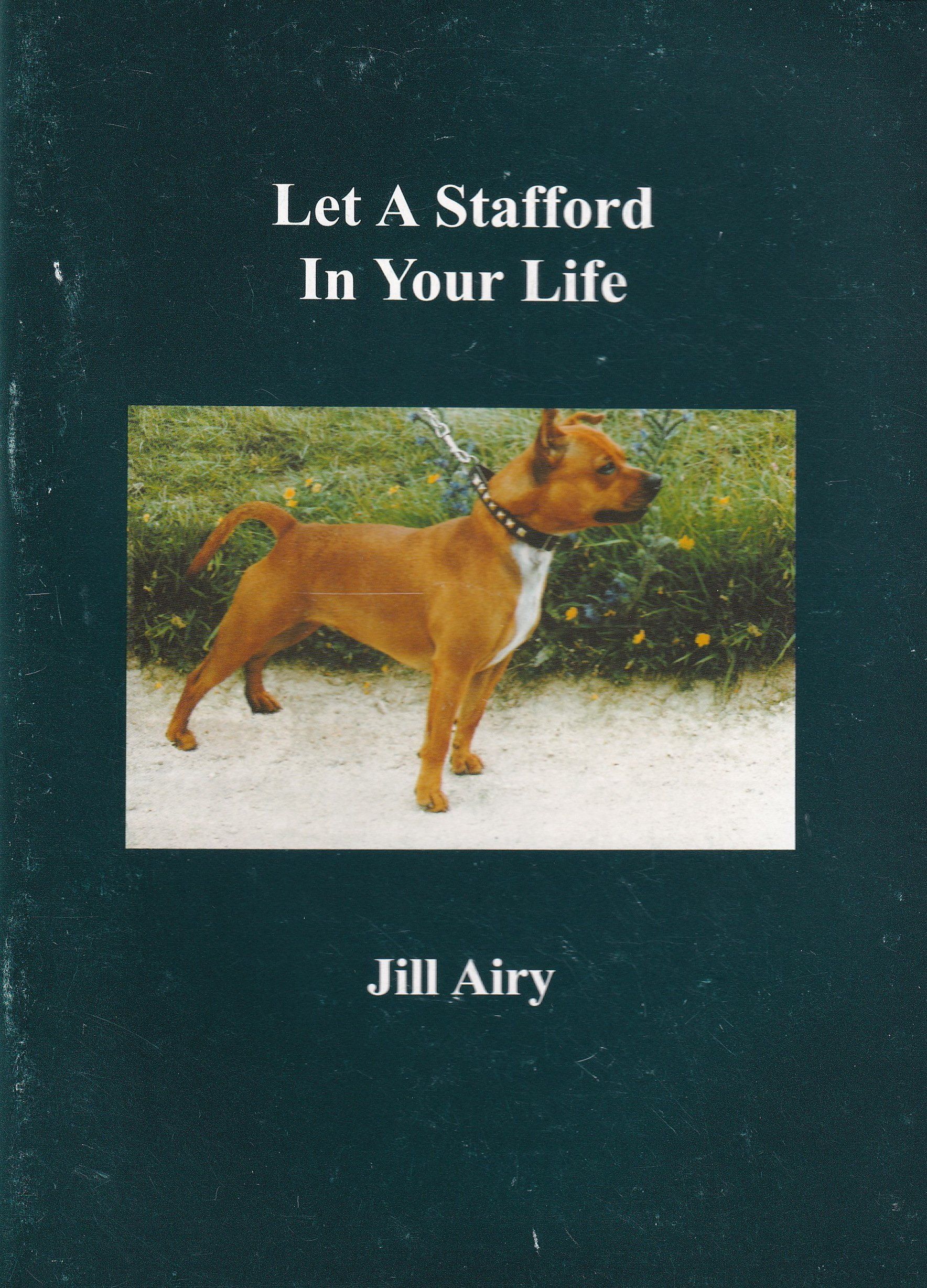First Published: 2003
A5 Booklet, 2003
56 pages
Weight: 55g approx
Privately Printed in the UK by Chalfont Bookbinders and Printers
Cover Photo: Roskey Free ‘N Easy
CONTENTS:
Foreword
Let A Stafford In Your Life
Peggy Barnard
It Could Never Happen to Barbara Woodhouse
One Up To The Trained Dog
Donkey Work
A Tale of Two Rescues
Walk Tall
Bird Dogs
The Stafford As A Guard Dog
A Last Work
Foreword:
The Staffordshire Bull Terrier - villain or clown? To the public at large he is usually one or the other because, whatever else he may be, unobtrusive he is not. Dog showing and dog fighting between them have brought him into the limelight. Once encountered, he fascinates ordinary dog lovers, many of whom buy themselves an innocent-looking puppy, only to find themselves out-gunned at every point. The hard truth is that there are far too many impulse buys of Stafford pups by people who have not been advised honestly by the breeder as to what they are taking on. The result is a harassed and bewildered owner and a frustrated puppy which gets passed from hand to hand until it may well end up in the Pit.
Some thirty years ago at the Championship Show I had a casual conversation about this with June and Roger Fisher (who was then President of the Western S.B.T. Club). This led to the inception of "The Stafford Companion Dog", first as training articles in the Club Magazine, and later in booklet form. Boosted by a foreword by Phil Drabble, this was well received and over five years one thousand copies were sold in aid of the Western S.B.T. Rescue service. How many of these actually bore fruit in the form of trained Staffords I shall never know - not that many, I suspect - but the acknowledgements I did get gladdened my heart. I was amazed by come-backs from places as diverse as Costa Rica and H.M. Prison, and delighted by a request from Dieter Fleig in Germany to print in translation there.
Marion Hughes, at that time editor of the Club Magazine, later persuaded me to follow up with a series of articles on the lives and exploits of my own companion dogs, to illustrate just how valuable an asset a trained Stafford can be, not forgetting his talent to amuse or surprise by his own interpretation of any unexpected situation. These were "Dog Days" when none ofus envisaged the coming threat to the very existence of our breed. If a Stafford puts a foot seriously wrong today a ripple of consternation and anxiety runs through us all. Temperament and control should therefore be paramount.
Phil Drabble did say that I could not have achieved my results in his early days as the dogs were too hard and aggressive, but that now some of this has been bred out and they are by and large more malleable. This is true, and I am disturbed by frequent comments in the Dog Press and Club Magazines regretting this fact. There seems to be some misconception that non-aggression equates with lack of spirit : the Stafford must be macho. Why? There is a time to fight and a time to refrain from fighting. All that is needed is the spirit that shows guts when needed.
The old training book is long out of print and in any case would not be practicable to follow in this day and age. For that reason I am reissuing the later articles to show a new generation how spirited and courageous Staffords can still be totally reliable and controllable while living lives of freedom, interest and fun such as the macho dog could never enjoy.
The Stafford differs from other dogs in two ways: firstly, he has a particular affection for the whole human race which replaces the normal pack instinct, destroyed by his being originally bred solely for fighting his own kind; secondly, inherited survival techniques have given him lightning reflexes, a very short fuse and a very deadly way of fighting when he gets into a barney. The combination is a tricky one; nevertheless, his intelligence, adaptability and potential as a companion dog are exceptional
Those who breed and show are of course aware of all this, but are unaffected by the inherent problems for pet owner. Their dogs are 'contained'. They are cherished and often much loved, but usually they do not, as the saying goes, 'mingle'. Yet from every litter produced to perpetuate 'The Line', all but one or two must be sold to 'good homes', and with the dog scene awash with surplus puppies and the Rescue services awash with discards, good usually means kind, but not so often knowledgeable and all too often the cuddly-bit suddenly turns into a brawling hooligan. A young Stafford should be treated like a small boy. What parent would expect a small boy to be content all day with a ball in the back garden and the odd game with a squeaky toy? If his high spirits and natural curiosity are not catered for, the boredom factor will soon find him some trouble to get into. This needs nipping in the bud straight away.
The secret is to channel his energy into interesting and rewarding games - seek games, scent games, ball games in mock competition with yourself - little and often with plenty of variety. Thus will he come to bond with you as more than just a source of food and comfort, and the games will lead naturally into proper training at three months old.
Habit is everything to a dog, who does not reason as we do, and for a Stafford it is more vitally important than for any other breed that he should be grounded in good habits so early that they overlay and overcome any hereditary bad ones. There are three basic commandments:
1. Thou shalt come at once when called, no matter what.
2. Thou shalt immediately 'loose' and/or 'leave' anything (animate or inanimate) when told to do so.
3. Thou shalt aggress upon no living thing except to order.
You can, of course, train a Stafford to do almost anything, but with these three disciplines you can have a happy and stress-free life together, even if you do not have the time or inclination to go any further. If at all possible, join a dog school, where the puppy will become socialised and you will get help with any problems (it is now possible to get puppies immunised much earlier, so that they can safely be taken out before three months). It is advisable to have a good training book to hand as well, which will show you how to get out of (almost) any hole you might have dug yourself into as well as a step by step guide as to how to carry out early training in the first place. My own canine bible is John Holmes' "The Family Dog: Its Choice And Training": this is unfortunately now out of print, but there are plenty of secondhand copies available on the Internet (try www.bookfinder.com).
I wish the very best of luck to anyone taking on their first Staffords, and trust that early struggles will result in a wonderful companion - a dog you can take anywhere, twice.

